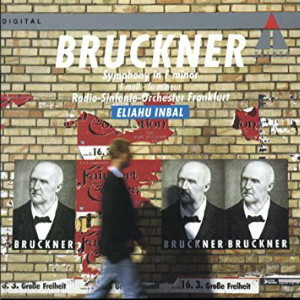 |
|
1 CD -
9031-72300-2 - (p) 1992
|
|
| ANTON BRUCKNER
(1824-1896) |
|
|
|
|
|
| Symphonie
f-moll - (Study Symphony,
1863) |
46' 14" |
|
-
Allegro molto vivace
|
17' 21" |
|
-
Andante molto
|
13' 03" |
|
| -
Scherzo: Schnell |
5' 22" |
|
| -
Finale: Allegro |
10'
11" |
|
|
|
|
| Radio-Sinfonie-Orchester
Frankfurt |
|
| Elihau Inbal,
Leitung |
|
|
|
|
|
Luogo
e data di registrazione |
|
Alte
Oper, Frankfurt (Germania) -
maggio 1991
|
|
|
Registrazione:
live / studio |
|
studio |
|
|
Producer /
Engineer |
|
Wolfgang
Mohr - Hans Bernhard Bätzing /
Detlef Kittler (HR) - Miachel
Brammann
|
|
|
Prima Edizione LP |
|
- |
|
|
Prima Edizione CD |
|
Teldec
- 9031-72300-2 - (1 CD) - durata
46' 14" - (p) 1991 - DDD |
|
|
Note |
|
Co-Produktion
mit dem HR Franfurt.
|
|
|
|
|
Anton Bruckner
was
31
years old when in December
1855 he took up the post of
Cothedral Organist
at Linz. He was already
experienced in the art of counterpoint,
had composed significant
works such as
the D minor Requiem
and
the Mass in B flat minor,
and
had acquired
considerable knowledge of
secular choral composition.
But his keenness to learn
knew no bounds. For six
years after
1855
he studied thorough bass,
harmony, counterpoint, canon
and fugue with the noted
Viennese theoretician Simon
Sechter. On 22nd November 1861 he
took his now famous
final
examination before the Jury
of the Gesellschaft der
Musikfreunde in
Vienna. He must, however,
have felt that his studies
with Sechter, which he had
so brilliantly completed,
were not extensive enough,
that he had not done justice
to the art and,
in porticular, that the field
of orchestration was
uncharted territory for him.
He therefore turned to Otto
Kitzler, a young conductor
in Linz and devoted adherent
of Richard Wagner and
Franz Liszt, asking
to be allowed
to study composition ond
orchestration with him.
Looking through the
composition exercises which
Kitzler set for
Bruckner, it is clear that
the teacher proceeded according
to a plan. First of all
he got Bruckner to write a
movement of a piano sonata,
thereafter a string quartet;
only then did he proceed to
orchestral works, with an
overture and a symphony. The
composition of this very
first of Bruckner’s
symphonies, a largescale
work in F minor, took three
and a half
months, from l5th February
until 26th may 1863.
In his Musikalische
Erinnerungen Kitzler
mentions this Study Symphony
and
expresses the view that it
was really no more than a "school
exercise", in which Bruckner
"was
not particularly inspired",
so that Kitzler had been
unable to say “anything
particularly
complimentary” about it. He
goes on to say: "He seemed
to be hurt by my reticence,
which I
thought strange in view of
his boundless modesty. Years
later he laughingly conceded
that I
had been right.” In
order to put his own opinion
of the work into writing,
Bruckner himself wrote the
note “school exercise” on
each of the four movements of the
symphony in a copy held in
the Vienna City Library.
It
is, however, characteristic
of Bruckner that, although
he regarded the orchestral
works which he produced for
Kitzler only as studies, he
did not fail
to show them to Franz
Lachner, the court conductor
in Munich, when he went
there in September 1863.
Lachner thought them
remarkable "for
the flow of thought,
structure and nobility", and
gave Bruckner to understand
that he would not be averse
to performing the Symphony
in F minor in the following
yeor. This performance did
not, however, take place.
What part did this "school
exercise"
play in Bruckner’s
development? One answer
might be that in this Study
Symphony Bruckner had
already created an
architectural style which
proved capable of
development. The first
movement and the finale each
comprise three themes and an
epilogue. Of the three
themes, the second - as in
the later symphonies - has a
songlike character and the
third is massive or
vigorous. It
is further of significance
that it also contains the
prototype of
the dynamic principle which
was so characteristic of
Bruckner, notably numerous
crescendi which, although
they are generally not so
long-breathed here as in the
later symphonies, point the
way to the celebrated
build-ups in later works.
Other features
are conventional. Thus the
setting of the middle
section of the Andante in
the minor is unusual for
Bruckner, and the Trio
section of the Scherzo makes
a somewhat colourless
impact. Bruckner drew his
inspiration for this work
from his diligent study of
Beethoven's symphonies;
however, the musical
language is not that of
Beethoven, but of
high romanticism.
Bruckner followed the Study
Symphony with his First in C
minor and only after that
composed the so-called "No.
0" in
D minor. A comparison of the
themes of the final
movements indicates how far
he had travelled from the
Study Symphony to "No. 0",
that of
the Study Symphony makes a
decidedly academic
impression, while the heroic
theme of "No. 0”
bears the hall-mark of
Bruckner’s genius.
Constantin
Floros
Translation:
Gery
Bramall
|
|
|